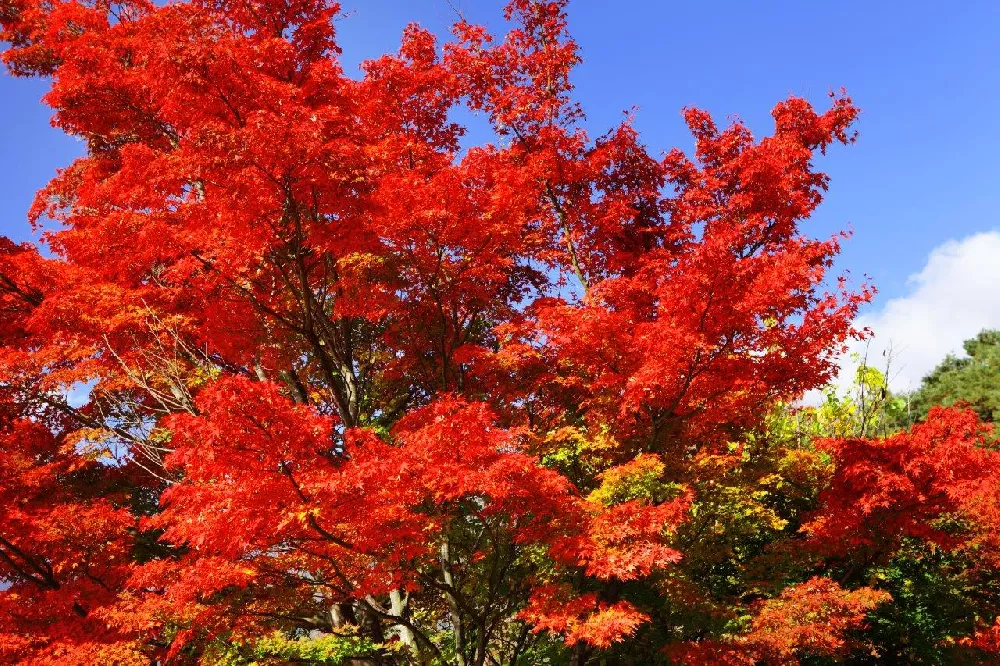- Home >
- Ornamental Plants >
- Flame Amur Maple Tree
Flame Amur Maple Tree for Sale - Buying & Growing Guide
The most sought-after ornamental feature of the flame amur maple tree is its fantastic fall color. Each year, this subspecies, Acer tataricum ginnala 'Flame,' turns its leaves from an ordinary green color to a fiery red that covers the entire canopy. The other main benefit of the flame amur maple tree is its versatility. Not only can you prune this plant into different forms, but you'll also have no problem growing it in nearly any location, regardless of what soil is present. Here are some flame amur tree highlights:
- Red flame-like fall color.
- Grows as a large shrub or as a small tree, depending on pruning.
- Hardier and more adaptable than most maple varieties.
Enter your zip code to find nearby stores that may carry this plant.
Plant Care
Sunlight

Grows best in areas of full sun exposure but survives in partial shade too.
Watering
Water about once per week or less. It has moderate drought tolerance when mature.
Fertilizing

Use a fertilizer with a balanced mix of nutrients in the early spring.
Planting and Care
Planting instructions
The flame amur maple tree is not picky when it comes to a growing location. This plant survives in a wide range of soil acidity and is hardy across a broad geographical range that spans from zone 3 to zone 8. The flame amur maple tree also adapts to both full sunlight and partial shade. Regardless of the location you select,, begin by digging a wide planting hole that is as deep as the root ball is tall.
Watering and nutrients
It is best to water a mature flame amur maple tree about once per week throughout the spring, summer, and fall months. However, this tree will likely survive with less water than that as it proves to have admirable drought tolerance after establishment. You won’t need to worry much about fertilization either — a single application of a general-purpose fertilizer in early spring will be enough to keep the flame amur maple tree healthy and thriving.
Pollination
Unlike many maple tree varieties, the flame amur maple tree has bisexual flowers that also hold more ornamental value than you might expect. These flowers appear in white clusters during the spring and can spread their pollen via the wind or by insect pollination. When pollination is successful, the flame amur maple tree can produce hundreds of fruits in the form of winged samaras — more commonly known as helicopters or whirlybirds. These samaras can spread relatively far by traveling on wind currents, allowing the flame amur maple tree to multiply with ease.
Pruning
The flame amur maple tree responds incredibly well to pruning. You can prune this plant aggressively to maintain a small size and shape if you wish, or trim it into different forms. While some gardeners keep their flame amur maple trees in a rounded shrub form, others train their plants to look more like single-stemmed trees. No matter what your pruning goal may be, make your cuts in the late winter to early spring.
Pests and diseases
Overall, the risks of pest infestation and diseases are quite low for the flame amur maple tree compared to most other maples. However, verticillium wilt is one of the few fungal diseases that can damage this plant. Along with that potential malady, there is a low risk that your flame amur maple tree may experience issues with yellow-bellied sap-suckers, aphids, and other insects such as mites and borers. Still, the disease and insect threats to this tree remain comparatively low.
Achieving maximum results
Perhaps the most prevalent complaint among those who grow the flame amur maple tree is that it can be difficult to control this plant’s spread. The flame amur maple tree can add as much as 2 feet of new growth in a single growing season, but the larger issue relates to this plant’s ability to produce copious amounts of samaras that spread efficiently through the air. When these fruits find fertile ground, they will soon spring up as new flame amur maple trees. Much of your maintenance for this plant may relate to controlling its spread.
FAQs
What is the relationship between amur maple and tatarian maple?
Initially, botanists considered the tatarian maple and the amur maple to be two distinct plant species, Acer tataricum, and Acer ginnala, respectively. The amur maple has since been reclassified as a subspecies of the tatarian maple, and now holds the official botanical title of Acer tataricum ginnala or Acer tataricum subsp. ginnala. Although this reclassification has occurred, many people may still refer to the amur maple by its old botanical name.
What do the leaves of a flame amur maple tree look like?
Aflame amur maple tree’s leaves are a variation of the maple leaves that you would likely recognize. The main difference is that the central lobe of a flame amur maple tree is significantly larger than the two lobes that appear next to it, giving each leaf a sharper, more pointed shape. These leaves appear early in the season and remain an uninspiring green color until they turn bright red in the fall.
Why do people plant the flame amur maple tree?
The principal motivation behind planting the flame amur maple tree is to see its brilliant fall colors every year. There are some other uses for this plant as well. Mainly, the flame amur maple tree is an excellent plant if you want to create a large hedge in a somewhat short time. Since it is adaptable to many soil types, this tree is also a great option for areas of your yard where other plants may have struggles.
Compare Similar Products
You can't add more Product Name - Product size to the cart.
OK








